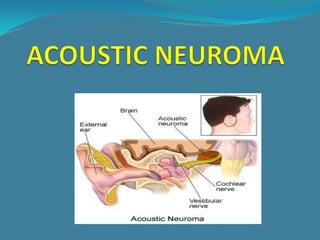
Acoustic neuroma
- 2. VESTIBULAR SCHWANNOMA/ ACOUSTIC NEUROMA It’s the most common intracranial schwannoma constituting 80 % of all cerebellopontine angle tumors. It’s benign encapsulated , extremely slow-growing tumor either solid or cystic which arises from the Schwann-cells (transition zone) of the vestibular nerve within the internal auditory canal are histologically composed of alternating regions of Antony type A and B areas. It can extend into the cerebellopontine angle. The number of newly diagnosed cases per year is around 13 per one million individuals. Bilateral AC is diagnostic of neurofibromatosis type 2.
- 3. ANATOMY OF CEREBELLOPONTINE ANGLE It’s a triangular area and bounded by: 1- Laterally: medial portion of posterior surface of temporal bone. 2- Medially: Edge of pons. 3- Posteriorly: cerebellar hemisphere and flocculus. 4- Superiorly: trigeminal nerve. CONTENTS: 1- Anterior inferior cerebellar artery. 2- 7th and 8th Cranial nerves.
- 4. FEATURES:
- 5. CLINICAL SYMPTOMS 1- Most common ; Progressive Unilateral SNHL (retrocochlear) present in 95% of cases and often accompanied by tinnitus which is present in 65% of cases. 2- Marked difficulty in understanding speech out of proportion to the pure tone hearing loss. 3- May present with sudden hearing loss. 4- True vertigo is seldom seen. 5- Earliest cranial nerve involved is 5th CN. 6- 4th , 6th, 9th , 10th , 11th and 12th can also be involved. 7- Rare presentations include facial numbness or pain, earache or facial weakness, cerebellar ataxia or symptoms of hydrocephalus (headache, visual disturbance, mental status change, nausea, and vomiting).
- 6. SIGNS Ear: normal otoscopy. Cranial nerves: 1- 5th CN: Earliest sign is impaired corneal reflex. Motor functions are affected rarely. 2- 7th CN: Sensory first; loss of sensation in the postero-superior aspect of EAC called Hitselberger sign. 3- 9th and 1oth pulsy: palatal, pharyngeal and laryngeal paralysis. 4- Eyes: Nystagmus. 5- Cerebellar signs present.
- 7. CLASSIFICATION OF AN ACCORDING TO SIZE Intameatal Extrameatal size Mm Grade 1 Small 1-10 Grade 2 Medium 11-20 Grade 3 Moderately large 21-30 Grade 4 Large 31-40 Grade 5 Giant More than 40
- 8. INVESTIGATIONS 1- Audiological tests: show features of retrocochlear hearing loss (high frequency SNHL) ; recruitment negative, poor speech discrimination score and presence of roll-over phenomenon. 2- Acoustic reflex: stapedial reflex decay or missing in up to 70% of patients. 3- Caloric test: diminished or absent normal test finding does not eliminate the diagnosis. 4- Plain x-ray: best view perorbital view ; difference of 1 mm in the vertical height of internal acoustic meatus is significant. 5- CT-scan; can not detect intermeatal tumors. 6- MRI; MRI with gadolinium enhancement is is gold standard.
- 10. Conservative Treatment • Since especially in the elderly vestibular schwannomas are slowly growing tumours, a wait and see strategy should be considered at least in the short term (6–12 months) for patients with a small vestibular schwannoma (in older patients and individuals in poor health). • Radiotherapy: Stereotactic radiosurgery (gamma knife) may stop vestibular schwannoma growth mainly in small intracanalicular and extracanalicular lesions. Radiosurgery as the first therapeutic option is recommended in bilateral vestibular schwannomas (e. g. morbus Recklinghausen) but only when the tumours are small. • Annual imaging is recommended for all patients being managed conservatively for the rest of their life or until vestibular schwannoma growth is seen to a certain limit.
- 11. Surgical Treatment Translabyrinthine approach in patients with medium sized and large tumours and in patients with small tumours with poor hearing . Middle fossa approach in patients with intracanalicular or small tumours with good hearing as an attempt to preserve residual hearing. Retrolabyrinthine or retrosigmoidal approaches in patients with large extracanalicular vestibular schwannomas Additional Useful Surgical Procedures • Intraoperative facial nerve monitoring. • Intraoperative hearing monitoring: may be useful in
- 12. Differential Diagnosis • Meningioma is, in most cases, recognized on radiologic features (tumour usually extrinsic to internal auditory canal, sessile with peritumoral dural enhancement and intratumoral calcifications). An enhanced “dural tail” is a distinguishing feature. • Other cerebellopontine angle lesions (cholesteatoma, arachnoid cyst, lipoma, haemangioma, glomus tumour, facial neuroma) can in most cases be recognized by their radiologic aspects and MRI characteristics
- 13. Prognosis Conservative Therapy With radiotherapy tumour control is around 96%, tumour regression 35%, lesion of the trigeminal nerve less than 5.6%, facial weakness 2%, and hearing loss 32%. There is no CSF leak and no mortality. If irradiation cannot stop tumour growth (in about 4% of cases), surgery is technically sometimes extremely difficult. Malignant transformation after radiotherapy is also valid for neuromas.
